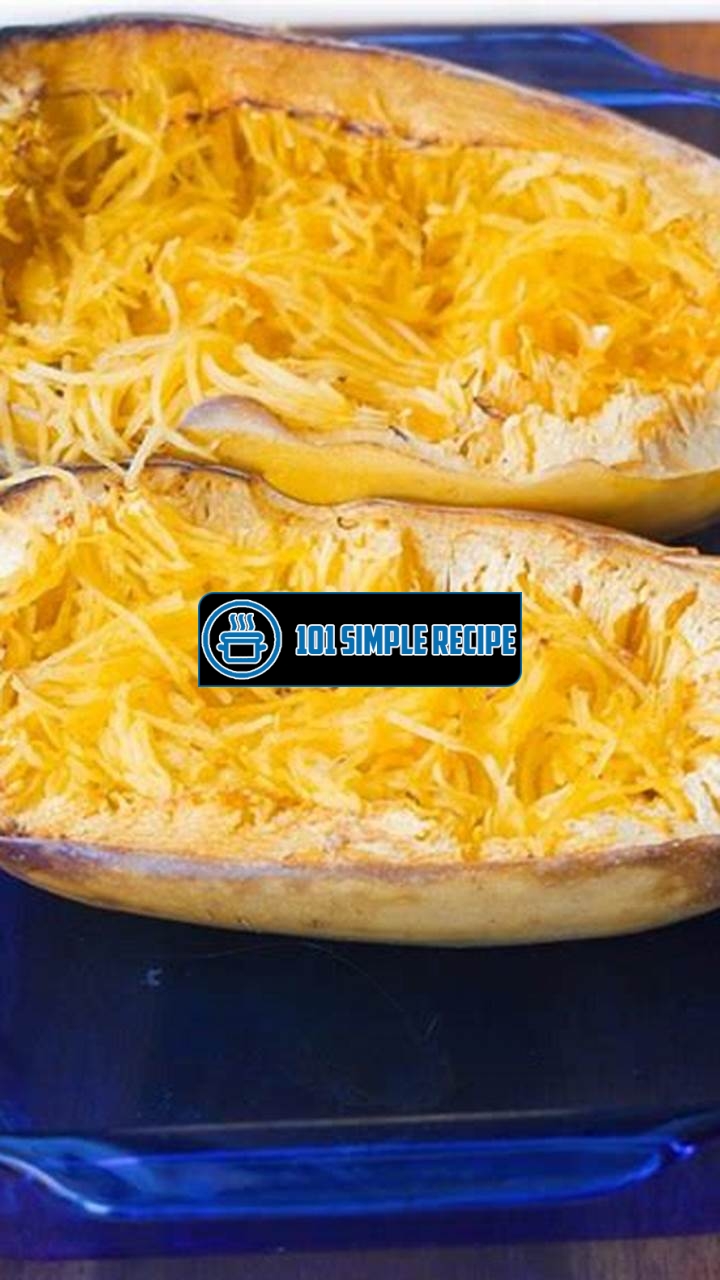Are you searching for a delicious and healthy alternative to traditional spaghetti? Look no further – baked spaghetti squash is here to satisfy your cravings! This versatile vegetable is a fantastic substitute for pasta, offering a low-carb and gluten-free option that doesn’t skimp on taste. With its tender, stringy texture and mild, nutty flavor, spaghetti squash serves as the perfect base for a variety of mouthwatering dishes. Whether you’re a vegetarian, vegan, or simply looking to incorporate more vegetables into your diet, this recipe is sure to impress. So, grab your apron and let’s dive into the world of extraordinary baked spaghetti squash! ️

Choosing the Right Spaghetti Squash
When it comes to baking a mouthwatering spaghetti squash, selecting the right one is crucial. The perfect spaghetti squash should have the ideal appearance, size, ripeness, texture, and be available during the right season. Let’s delve into each of these factors to ensure you choose the best spaghetti squash for your baking endeavors.
Appearance and Size
The appearance and size of a spaghetti squash are essential when deciding which one to bake. Look for a squash that has a vibrant yellow color and a firm, smooth skin. Avoid any squashes with discoloration or soft spots, as these may indicate that the vegetable is not fresh or has spoiled. Additionally, consider the size of the squash. A medium-sized spaghetti squash, weighing around 4 to 7 pounds, is typically the most suitable for baking. This size ensures that the squash cooks evenly and yields long, spaghetti-like strands.
Ripeness and Texture
Another crucial aspect to consider is the ripeness and texture of the spaghetti squash. A ripe spaghetti squash will have a firm outer skin that cannot be easily punctured. To determine ripeness, give the squash a gentle tap; if it sounds hollow, it is likely mature and ready to be baked. Additionally, pay attention to the texture of the squash. It should feel heavy and dense, indicating that it is packed with sweet and tender flesh. Avoid squashes that feel lightweight or have a mushy texture, as these are signs of under-ripeness or over-ripeness.
Seasonality and Availability
Lastly, consider the seasonality and availability of spaghetti squash. Although spaghetti squash is generally available year-round, its peak season runs from early fall to winter. During this time, the squash is at its freshest and most flavorful. If possible, try to purchase your squash during this period to experience its optimal taste and texture. However, if you can’t find fresh spaghetti squash during the peak season, many grocery stores offer pre-packaged, refrigerated squash that can still be delicious when baked.
By taking into account the appearance, size, ripeness, texture, seasonality, and availability of spaghetti squash, you can ensure that your baked dish turns out mouthwateringly delicious. Remember to choose a squash with a vibrant appearance, medium size, firm texture, and optimum ripeness. Additionally, aim to buy your squash during its peak season, although pre-packaged options are available throughout the year.
Preparing the Squash for Baking
When it comes to making mouthwatering baked spaghetti squash, proper preparation is key. Follow these necessary steps to ensure your squash is ready for the oven:
Washing and Drying
To start, give your spaghetti squash a good wash under running water. This will help remove any dirt or debris that may be on the surface. Use your hands or a vegetable brush to gently scrub the skin. Once you’ve thoroughly washed the squash, pat it dry with a clean towel or paper towels to remove excess moisture.
Trimming and Cutting
Next, it’s time to trim and cut the squash. Take a sharp knife and carefully trim off the stem end of the spaghetti squash, making sure to remove any tough or fibrous parts. This will create a stable base for the squash to sit on while baking. Once the stem end is trimmed, slice the squash in half lengthwise. Be cautious when doing this, as the squash can be tough to cut through. Feel free to use a cutting board for stability and always keep your fingers away from the blade.
Important note: When cutting the squash, make sure to use a very sharp knife and exercise caution to avoid any accidents. It’s also a good idea to stabilize the squash on a cutting board to prevent it from rolling while you cut.
Seed Removal and Scraping
After cutting the spaghetti squash in half, it’s time to remove the seeds and scrape out the stringy flesh. Use a spoon or a sturdy metal scoop to gently scrape out the seeds and the center of the squash. Be thorough in this process, making sure to remove all the seeds and any excess strands of flesh.
Handy tip: You can save the seeds from the squash and roast them separately for a tasty and nutritious snack. Simply rinse the seeds, pat them dry, toss them with a little olive oil and seasoning of your choice, then spread them out on a baking sheet and roast at 325°F for about 15-20 minutes or until they’re golden and crispy.
By properly preparing the spaghetti squash before baking, you’ll ensure that it cooks evenly and yields perfect, mouthwatering strands. So remember, wash and dry the squash, trim and cut it with care, and don’t forget to remove the seeds and scrape out the flesh. With these steps completed, you’re now ready to move on to the next stage of the recipe and transform your spaghetti squash into a delicious baked dish!
To bake whole spaghetti squash, follow this recipe from 101 Simple Recipe. It provides step-by-step instructions on how to prepare and cook spaghetti squash.
Baking Methods for Spaghetti Squash
When it comes to baking whole spaghetti squash, there are several techniques you can explore to achieve perfectly cooked and mouthwatering results. Whether you prefer the traditional oven method, the quick and convenient microwave option, or the set-and-forget slow cooker approach, each technique has its advantages and can yield deliciously tender spaghetti squash strands that will leave you craving for more. Let’s delve into each method in detail:
Oven Baking
Oven baking is a tried and true method for cooking spaghetti squash. It allows for even heat distribution, resulting in a consistent texture and flavor. To oven bake your spaghetti squash, start by preheating your oven to 400°F (200°C). While the oven is heating up, prepare your spaghetti squash by washing and cutting it in half lengthwise. Scoop out the seeds and pulp from the center. Place the squash halves on a baking sheet, cut side down, and bake for approximately 40-50 minutes, or until the flesh is fork-tender.
This baking method offers a few advantages. Firstly, the longer cooking time allows the natural sugars in the squash to caramelize, enhancing its sweetness and flavor. Additionally, oven baking provides a slightly roasted taste and texture, adding depth to your spaghetti squash dishes.
Microwave Baking
If you’re short on time, microwave baking is a convenient option that can deliver satisfying results. To bake spaghetti squash in the microwave, start by piercing the skin of the squash in several places with a fork or a sharp knife. This helps prevent the squash from bursting during cooking. Next, place the whole squash on a microwave-safe dish and cook on high power for approximately 10-12 minutes, turning the squash halfway through the cooking process.
Microwave baking offers the advantage of speed, allowing you to enjoy a deliciously tender spaghetti squash in a fraction of the time compared to other methods. However, it’s important to note that the texture of the squash may be slightly different compared to oven baking. Microwaving tends to result in a softer and moister flesh.
Slow Cooker Baking
If you prefer a hands-off approach to cooking, the slow cooker method is perfect for you. This technique requires minimal effort and can yield wonderfully tender spaghetti squash. To bake spaghetti squash in a slow cooker, begin by washing the squash and piercing it in several places with a fork or a knife. Place the whole squash in the slow cooker and cook on low heat for 4-6 hours or on high heat for 2-3 hours, depending on the size of your squash.
The slow cooker method allows the squash to cook slowly and evenly, resulting in a tender texture that easily separates into strands. The low and slow cooking process also helps the flavors develop, creating a rich and savory taste.
So, whether you opt for the classic oven baking, the quick microwave option, or the convenient slow cooker method, each technique offers a unique set of advantages. Choose the method that suits your time constraints and flavor preferences, and get ready to enjoy a delightful and nutritious meal with your mouthwatering baked spaghetti squash!
You can also try making a delicious side dish by using the ranch oyster crackers recipe from 101 Simple Recipe. It’s a great addition to your spaghetti squash meal.
Tasty Serving Ideas for Spaghetti Squash
Discover delicious and creative ways to enjoy baked spaghetti squash as a main dish or side.
Classic Spaghetti and Meatballs
Indulge in the classic combination of spaghetti and meatballs, but with a healthy twist by substituting regular pasta with roasted spaghetti squash. The tender strands of squash perfectly mimic the texture of spaghetti noodles, creating a satisfying and nutritious meal.
Start by baking a whole spaghetti squash until it’s tender and can be easily scraped into strands. While the squash is baking, prepare your favorite meatball recipe. Whether you prefer beef, turkey, or vegetarian meatballs, they will pair wonderfully with the squash.
Once the squash is cooked and scraped, top it with the meatballs and your favorite marinara sauce. Garnish with freshly grated Parmesan cheese and a sprinkle of fresh herbs for added flavor. This hearty and comforting dish is sure to be a hit with the whole family.
Garlic Parmesan Spaghetti Squash
Elevate the flavors of spaghetti squash by infusing it with garlic and Parmesan. This simple yet gourmet-inspired dish is bursting with savory and cheesy goodness.
To make garlic Parmesan spaghetti squash, start by baking a whole spaghetti squash until it’s tender. Once cooked, scrape the flesh into strands and set aside.
In a skillet, melt butter and add minced garlic, sautéing until fragrant. Add the spaghetti squash strands to the skillet and toss with the garlic butter mixture. Sprinkle generously with grated Parmesan cheese and continue to toss until the cheese is melted and well incorporated.
For an added touch of richness, sprinkle some chopped fresh parsley or basil and drizzle with a little extra virgin olive oil before serving. This irresistible dish is a perfect side or even a light main course.
Spaghetti Squash Carbonara
Put a creative twist on the classic Italian carbonara pasta dish by using spaghetti squash instead of traditional spaghetti. The result is a lighter yet equally delicious version of the beloved recipe.
Start by baking a whole spaghetti squash until it’s cooked through, then scrape out the flesh into strands.
In a skillet, cook diced bacon until crispy. Remove the bacon from the pan and set it aside, leaving behind a small amount of bacon fat in the pan. In the same skillet, sauté chopped onions and minced garlic until they become fragrant.
Add the spaghetti squash strands to the skillet, along with beaten eggs, grated Parmesan cheese, and the cooked bacon. Toss everything together until the eggs are fully cooked and the cheese is melted and creamy.
Season with salt and freshly ground black pepper to taste, and garnish with chopped fresh parsley or basil. This unique twist on carbonara is a low-carb alternative that is still packed with flavor and will satisfy your pasta cravings.
If you’re looking for a unique twist, you can try the cookie in a mug recipe from 101 Simple Recipe. It’s a quick and easy dessert that pairs well with spaghetti squash.
Health Benefits of Spaghetti Squash
Spaghetti squash is a delicious and nutritious vegetable that can be a versatile addition to your diet. Not only does it offer a low-calorie alternative to pasta, but it is also rich in vitamins and minerals that can support overall health. Additionally, spaghetti squash has the potential to aid in weight loss, making it an excellent choice for those looking to shed a few pounds. Let’s explore these health benefits in more detail:
Low-Calorie Alternative to Pasta
If you’re watching your calorie intake or looking for a lighter option than traditional pasta, spaghetti squash is a fantastic alternative. Unlike regular pasta, which can be high in calories and carbohydrates, spaghetti squash is significantly lower in both. With just around 40 calories per cup, this vegetable allows you to enjoy a satisfying meal without the guilt.
Rich in Vitamins and Minerals
Spaghetti squash is a nutrient-dense food that can contribute to your daily vitamin and mineral intake. It is an excellent source of vitamins A and C, both of which play a crucial role in supporting a healthy immune system. These vitamins also act as antioxidants, fighting off harmful free radicals in the body. Additionally, spaghetti squash contains potassium, which helps maintain proper heart and muscle function. The abundance of fiber in this vegetable promotes healthy digestion and can contribute to feelings of fullness.
Potential Weight Loss Aid
If you’re looking to shed excess pounds, incorporating spaghetti squash into your diet may help you reach your goals. This vegetable is not only low in calories, but it is also high in fiber. High-fiber foods can help you feel fuller for longer, reducing the temptation to overeat. Furthermore, spaghetti squash is a good source of water, which adds volume to your meals without additional calories. By replacing high-calorie pasta with this nutrient-packed alternative, you can create a more balanced and weight-loss-friendly plate.
Overall, spaghetti squash offers numerous health benefits that make it a valuable addition to any diet. Its low-calorie nature, rich vitamin and mineral content, and potential weight loss aid qualities make it a smart choice for those looking to improve their overall health and well-being. Give it a try and explore the many delicious ways to incorporate this versatile vegetable into your meals!
Thank you for reading our article on baking whole spaghetti squash. We hope you found it helpful and informative. If you enjoyed this recipe, be sure to visit our website again for more delicious and healthy cooking ideas. Whether you’re a seasoned chef or just starting out in the kitchen, we have something for everyone. Stay tuned for more mouthwatering recipes and cooking tips!
Frequently Asked Questions
Here are some frequently asked questions about baking whole spaghetti squash:
| No. | Questions | Answers |
|---|---|---|
| 1. | How do I choose a good spaghetti squash at the grocery store? | Look for a squash that feels heavy for its size and has a firm, dry stem. Avoid ones with soft spots or mold. |
| 2. | Do I need to cut the squash before baking it whole? | No, you can bake the squash whole without cutting it. Just make sure to prick it with a fork or knife to allow steam to escape. |
| 3. | How long does it take to bake a whole spaghetti squash? | It typically takes about 45-60 minutes to bake a whole spaghetti squash, depending on its size. The flesh should be tender and easily pierced with a fork. |
| 4. | Can I store leftover baked spaghetti squash? | Yes, you can store leftover baked spaghetti squash in an airtight container in the refrigerator for up to 5 days. Reheat it in the microwave or oven before serving. |
| 5. | What can I do with leftover cooked spaghetti squash? | Leftover cooked spaghetti squash can be used as a healthy alternative to pasta in various recipes, such as salads, stir-fries, or as a base for sauces. |
| 6. | Can I freeze baked spaghetti squash? | Yes, you can freeze baked spaghetti squash. Place the cooled squash strands in a freezer-safe container or bag, and it can be stored for up to 3 months. Thaw it in the refrigerator before using. |
Closing Thoughts
We hope you have a wonderful cooking experience with baking whole spaghetti squash. It’s a versatile and nutritious vegetable that can be enjoyed in various dishes. Whether you’re following a gluten-free diet, looking for a low-carb alternative to pasta, or simply want to try something new, spaghetti squash is a fantastic option. So gather your ingredients, preheat your oven, and get ready to enjoy a delicious and healthy meal. Stay tuned to our website for more exciting recipes and cooking inspiration. Happy baking!
Jump to Recipe
Baking Whole Spaghetti Squash

Learn how to bake a whole spaghetti squash for a delicious and healthy meal. This recipe is simple, flavorful, and perfect for those following a gluten-free or low-carb diet.
- 1 whole spaghetti squash
- Olive oil
- Salt and pepper to taste
- Preheat your oven to 400°F (200°C).
- Wash the spaghetti squash and use a fork or knife to prick several holes all around it. This allows steam to escape while baking.
- Place the whole spaghetti squash on a baking sheet and bake it in the preheated oven for 45-60 minutes, or until it is tender and easily pierced with a fork.
- Using oven mitts or a kitchen towel, carefully remove the squash from the oven. Let it cool for a few minutes before handling.
- Cut the squash in half lengthwise and remove the seeds using a spoon. Use a fork to scrape the flesh and create spaghetti-like strands. Serve with your favorite sauce or toppings.
- Sit back, relax, and enjoy your delicious and healthy baked spaghetti squash!






